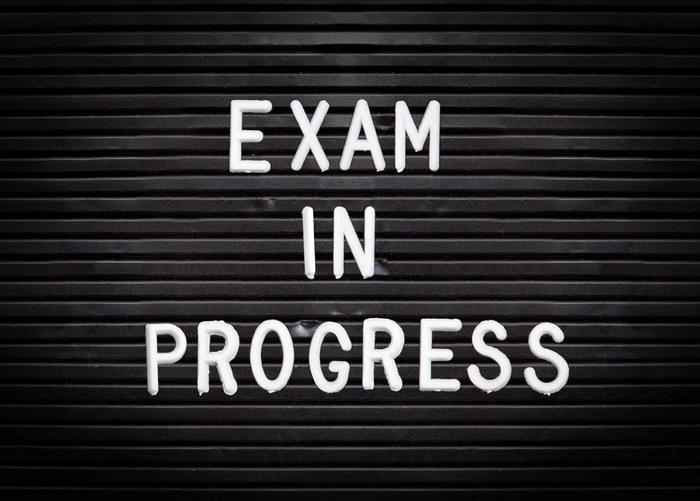What is the LSAT Exam?
The Law School Admissions Test (LSAT) is a written standardized test administered by the Law School Admission Council. It is one of the fundamental requirements for applying to law school in the United States, Canada, and a host of other countries.
The importance of the LSAT for prospective law students cannot be underestimated. Just a few points off your grade can mean the difference between being accepted or rejected.
It must be noted that the LSAT isn't the sole exam requirement for entering law school. There are other tests out there you can use. However, LSATs are certainly the most respected and accepted, and taking it will maximize your chances exponentially in getting into the law school of your dreams.
The LSAT is unlike any other admissions tests you might have taken in that it doesn't test knowledge. Instead, it is a skill-based test designed to evaluate if you have what it takes to be successful for the rigors of law school.
LSATs are notorious for being one of the hardest admissions tests one can take. However, this stems from the fact that the LSAT is a very different exam altogether. With the proper knowledge, foresight, and, most of all, practice, you can pass the LSAT.
So our first step is to look at what exactly is being tested with the LSAT.
Parts of the LSAT Exam
The LSAT is a written exam that tests students in 5 critical areas. It lasts almost half a day.
Exam takers are given 35 minutes per area, with a 15-minute break after the third section. Each section is composed of around 25 — 28 questions presented in multiple-choice style format.
To give you an idea, here are the areas of testing when you take the LSATs.
Logical Reasoning
The majority of the section will present short paragraphs. You will need to deduce the correct answer by finding relevant pieces of information and using your ability to reason. You'll apply critical thinking and analysis skills, as well as sound arguments and smart assumptions.
Analytical Reasoning
This section is all about logic games. You're given a scenario with a set of rules, and several objectives (like ordering or assigning items). You'll then be asked to make assumptions or conclusions based on them to arrive at the correct answer. These are meant to simulate the same analysis you'll make when solving legal problems in the future.
You'll need to rely on superior logic and critical thinking to analyze specific situations to get the correct answer. Many find the logic game question to be the most difficult and challenging out of all the categories in the LSAT.
Reading Comprehension
Here, you'll be given long, academic passages to read and comprehend. You then need to deduce the logic, structure, and purpose of the text in order to choose the correct answer successfully. You'll also be asked to compare texts talking about the same topic and comparing the two to identify relationships and differences between them.
Most of the topics covered are from the areas of humanities, social sciences, and, of course, law. This section is meant to test your ability to make sense out of even the densest and long-winded of text passages, a situation you'll often find yourself in a law career.
Experimental / Variable
The fourth section is an Experimental one. This is the only unscored part of your test, meaning it won't impact your grade. This variable section is used to experiment with questions for future tests and is intended for the developers of the LSAT.
And before you try to discover these sections, we're telling you right now — don't even try it. It's blended well into the rest of the sections, that finding it is futile. We recommend just trying to do your best in every question, and you'll be fine.
Writing Sample
The final section of the LSAT is the Writing Sample and is the only one not presented in multiple-choice. It is, instead, in an essay format.
This section requires you to pick one of two options on a given topic, usually something neutral. You'll then need to defend your choice and cite your arguments, given the facts and data about the subject.
It's important to note that there is no "right" or "wrong" answer in the Writing Sample section. Instead, the test is there to see how well you present your arguments, a necessary skill when practicing law.
The Writing Sample is also not factored into your final score. Instead, it's sent to law schools as part of your admission and used as they see fit to evaluate your application.
When and Where Can You Take the LSAT?
The LSATs are administered four times each year. The current schedule is every February, June, September, and December. In some years, tests are given in October rather than September. It's held in testing centers all across the United States
It's important to note that seating is limited in each LSAT season and that most law schools require that you take the LSATs a few months before the admissions season starts. Hence, it's wise to take the LSATs as early as possible.
Basic LSAT Fees
The Basic Fee to apply for the LSAT is $200 (US dollars). This includes the test itself, plus the LSAT writing sample section. If you attempt to book a test date after the registration deadline, and an additional fee of $100 is charged, up to 12 days after the deadline date.
For those who cannot physically take the exam in a certified testing center, you can request that LSAC establish one near your area. This requires Nonpublished Test Center Fees of $295 for those living in the US and $390 for all other international locations.
You can also request to change the date or location of your testing center after you have booked it. This costs $125 per change (either date or location). Note that requests are subject to seat availability and if the deadline on your target testing center has not yet passed.
LSAT tests are all machine-scored. If you suspect there's an error in your scoring, you may request that it be rechecked by hand. To do so, simply pay the Handscoring Fee of $100. Any discrepancies detected on the hand scoring will be updated accordingly on your LSAT results.
Other LSAT Fees
The LSAT fee is about all you need to take and receive your scores, but you can avail of other added services to make your application experience much more straightforward.
One of the most common services availed is the Credential Assembly Service (CAS), which costs $195, good for five years. With it, you can compile all of your law school admission requirements into one convenient location, which law schools can access online. This includes all of your LSAT scores, transcripts, and letters of recommendation.
Note that some law schools require that applicants use the CAS service.
To send your CAS credentials, however, you will need to get a Law School Report, which costs $45 each. This is required for each law school you apply to, per admission year. So even if you apply for the same school in previous years, you still need to get a new report for each subsequent year you wish to apply.
Take note that Law School Reports are requested by the law school. You can't personally request that your report be sent to any person or institution.
What to Expect on Exam Day
To help you prepare your LSAT day, let's walk you through what you can expect come exam day. By knowing what to expect, you can reduce some of the nervousness you might feel during that day.
One thing you need to know is that the LSAT is strictly administered and extremely structured, just like any examination. This means you need to follow the rules to the letter or risk being prematurely rejected from testing centers.
The LSAT is divided into five 35-minute sections, which translates to a total of 3 hours and 30 minutes. A 15-minute break is included after the third section of the test.
That's a pretty long period of physical and mental exhaustion, so it's best that you prepare for it. Take a big breakfast or meal prior to taking the test and relieve yourself as needed. Any time taken to go to the restroom is taken away from your total, so keep this in mind.
It's also imperative that you be on time on test day. Any latecomers will be rejected outright from the testing room.
First, you need to bring the LSAT admission ticket you bought on testing day, together with a government-issued ID and photo.
You'll also be allowed to bring a limited number of items with you during testing day. These include an analog watch, HB pencils, wallets, and keys. Food and beverages can also be brought for your inconvenience. All of these must be placed in a clear plastic bag.
As expected, you can't bring electronic devices of any kind to the testing center, as well as aids such as rulers.
LSATs are administered by test supervisors, who oversee every step of the examination process. When you arrive at the testing centers, they would also be the one to assign you to your designated seats.
When the test is about to begin, the exam materials will be distributed to you. The test supervisor will then announce the start and stop time of the exam. Pay careful attention to them and follow their instructions exactly. We can't stress this enough.
After the third test, you'll be given a short 15-minute break to eat or relax for a bit. Supervisors will collect all test materials prior to the break. Note that you're not allowed to leave the testing area, nor use your mobile phone.
How the LSAT is Graded and Understanding It.
LSATs are graded similarly to your typical test. Correct answers are tallied to your final grade. The grading system, however, makes use of three types of "scoring" to give a much better view of your results to admissions officials.
The first is the Raw Score and tells officials how many questions you answered correctly. For example, a raw score of 80 / 100 means you answered 80 out of 100 items correctly. This is the usual scoring we're used to.
The second is a Scaled Score and is a scaled conversion of your raw score to fit in the 120 — 180 range. This is done because LSATs are normalized; meaning, it is adjusted to account for inconsistencies and differences in difficulty from one administration to the other.
The last is your Percentile Score. This is a comparative score that tells you how well you did in relation to other LSAT examinees. For example, a 95% percentile score means you're in the top 9% out of all LSAT takers.
Compared to the raw score, a percentile score generally gives a more excellent picture of how well you did in the LSAT. It also takes into account the general jumps in difficulty between test administrations over time.
The majority of law schools use an index formula that takes your LSAT and undergraduate GPA into account. In most cases, the LSAT has a higher weight, pinning more importance into this than ever.
When you think about it, this is actually an excellent thing. Doing good on your LSATs will give you a fair shot at going to law school, even if you did horribly during your undergraduate years. This also takes into account those who might have irregular experiences in college, and might not have an impressive GPA as a result.
In other words, LSATs are an excellent yardstick to measure your future success in law school.
Getting Your Scores, Retakes, and Cancellations
You can get your LSAT scores as early as three to four weeks after you've taken the test. You usually get this via email.
You also have the option of canceling your LSAT scores up to six days after taking the exam, before you receive your scores. Admissions officials will still see that you have taken the LSAT exam on that particular session, but the score will be withheld.
If you feel there were mistakes with your exam or test scores, you can formally file a complaint with the LSAC. In the past, successfully resolved claims included misconduct by exam supervisors or (rarely) an unfairly administered question.
You can also retake the LSAT up to seven times over your lifetime. This doesn't include any attempts you may have made prior to September 2019, when this rule was created. Law school admissions officials will see all of your scores from all your attempts, but they generally only take your highest score into account.
Preparing for the LSAT Exam
While being known to be one of the most challenging exams in the world, the LSAT is by no means impossible. In fact, with some practice, you can easily ace the exam regardless of your previous academic experience.
Practice factors in significantly with the LSAT. Since the exam tests your skills and not your knowledge, learning how to answer the questions correctly is much more critical than knowing cold, hard facts.
The nature of LSAT questions used every year used is pretty much consistent, therefore allowing prospective takers to practice on previous year's questionnaires.
In fact, the LSAC highly recommends that you give ample time in preparing for the LSAT. At the minimum, you should allow three months of practice and preparation, more if you want to ace it. Don't even think of cramming for the LSAT — that's just a recipe for disaster!
With that said, there are plenty of ways to prepare for the LSAT, some officially endorsed by the LSAC, while others are more "do it yourself."
How to Study for the LSAT Exam
Here are some of the ways you can prepare for the LSAT
Self Study
The easiest, of course, is to Self Study. This is more or less the cheapest option since you don't need to hire anyone to help you. There are tons of resources and support available for free on the Internet in forums or LSAT-dedicated websites.
Self-studying also allows you to control the pace at which you study since you know yourself best. You can also tailor-fit your practice sessions depending on areas where you need the most help.
However, the self-study produces inconsistent results, with varying degrees of effectiveness. While you have abundant resources online, a lot of them might not be accurate or even credible. And when you encounter difficulty or questions, you'll often have a hard time finding answers. Also, if you do, it will most likely be conflicting, and you would have no way of verifying if they're correct or not.
But what mostly makes self study difficult is that you're going against your human nature. Doing this successfully requires tons of discipline and excellent study habits. If you lack in any of these, you might be doing yourself more harm than good.
With that said, however, self-studying is still an important skill to have. Even if you consider the other study options presented in this section, you'll still need to do some self-studying one way or another.
In fact, the other methods, like getting courses or getting one-on-one tutoring, is all just a boost to your self-study efforts.
Succeeding with Self Study
While challenging, you can succeed in self-studying. The key is finding the right learning materials and figuring out a plan that maximizes your chances.
For starters, try taking the LSAT Prep Test. These are exam questions taken from actual LSAT examinations from older years. As LSAC officially endorses these, these are great places to gauge your readiness for the test.
You can download a free Prep Test from the LSAC website, or download them from accredited test prep companies.
When taking the Prep Test, be sure to simulate the conditions on exam day as much as you can. This means timing yourself strictly as per the examination itself. A good strategy is to also take it in a public place, such as a library, so that you can acclimate yourself to what the environment will likely be on test day.
Another excellent resource for studying for the LSATs is to get yourself the official LSAT Prep Books. These contain sample exam questions with full explanations of the answers. They also include crucial information about the LSATs and tips you can use on exam day.
Since they're written by the LSAT test writers themselves, it's one of the most credible resources you'll ever get your hands on.
Test Prep Courses
If you don't want to go through the hassle of having to scour the Internet for resources or figuring out a study plan of your own, a Test Prep course is a good alternative.
Test Prep Courses are a more comprehensive way of studying for the LSATs. The most significant advantage is that they usually provide a complete study plan for you, including all the study materials you'll need. As the student, all you need to do is to follow it, study it, and practice every day.
You also get a wide variety of courses to fit specific needs or areas of improvement. What's more, the majority of them offer online test courses with valuable feedback so you'd know where you went wrong and how you can improve. This is undoubtedly a piece of invaluable information to have.
Right now, there are lots of Test Prep companies offering these courses, so you have a lot to choose from depending on your needs and preferences.
Of course, the obvious drawback is that it can be expensive. Will the price varies, it will generally set you back around $500 or more. That's way more than what the LSAT costs!
You'll also get less personalized instruction, and you get minimal chances to ask questions. You also get variable quality, as not all test prep companies are created equal.
Succeeding with Test Prep
The key with Test Prep companies is choosing the right one. An excellent place to start is with the LSAC website. They list a comprehensive list of their accredited Test Prep companies there. The list is pretty long, so we're sure you're bound to find the perfect one for you there.
However, you should know that being accredited by LSAC has nothing to do with the quality and performance of the Test Prep companies themselves. Again, due diligence on your part is essential here.
If you're eligible for an LSAC fee waiver, some test prep companies also offer free test prep courses to these recipients. These are qualified individuals but with absolutely no way to pay for the LSAT, so this is a fantastic blessing for them.
If you're one of them, take this option. Prep companies who offer this are conveniently marked in the LSAC website.
Lastly, having a test prep course doesn't replace hard work and diligence in practicing every day. Remember, these courses are just designed to streamline the process. You still need to put in the hours and work to make the most out of your prep course.
One-on-One Tutoring
Lastly, you can opt to get a tutor to teach you. This is the most comprehensive, but also the most expensive option out there. Due to its personal nature, tutoring will cost you thousands of dollars in fees.
However, there's no denying the merits of one-on-one tutoring. An excellent one will be able to identify the areas where you need the most improvement and design a customized lesson plan to address that. You'll also get constant encouragement, and being accountable to someone else means you'll most likely follow through with your study plans.
One-on-one tutoring is excellent if you have no idea how to structure your LSAT preparation plans. It's also ideal if you're a busy professional who also has to study for the LSAT exam.
Succeeding in One-on-One Tutoring
Apart from the exorbitant fees, there's really nothing much negative about one-on-one tutoring. The key is doing thorough research. Tutoring is only as successful as the quality of the person you hire.
Scouting for a tutor from reputable companies is a good place to start. Your instructor should have the track record to be able to help you out successfully. Remember, you're staking your very future on them, so be very picky.
If you're dealing with the private tutors directly, make sure they can be trusted. If possible, only work with recommendations from reputable sources like professors, colleagues, or friends who have hired them before.
Here's a rundown of some things you need to look into with your instructor:
Their LSAT Score — This is the most basic requirement. What was the actual LSAT score they got? Of course, it's hard to trust someone to teach you when they themselves didn't score very well. Most tutoring companies require at least a 160 with their instructors; others demand higher.
Professional Qualifications — You can also consider their background, both academic and professional. Have they practiced law, and for how long? If they have practiced the skills necessary to pass the LSAT, they're much better equipped to help you out.
Success Rate — this is a good gauge of their teaching ability. When meeting a prospective instructor, you can ask the average LSAT scores their students get. The higher, the better. You can also scour the Internet for reviews of that instructor (if available), and see what they have to say.
Teaching Style — this is hard to quantify but is fundamental to your success. The way they teach must be compatible with the way you learn; otherwise, it just won't work. If possible, ask for a trial run before hiring them to see this firsthand.
Personality — More than just credentials, you have to somehow "jive" with your instructor. This is more important than you think. If your personality is a good fit with that of your tutor, you'll be able to have an easier time learning. You might even find yourself enjoying the process, and this leads to better learning overall.
As a rule of thumb, it's safer to deal with companies when hiring one-on-one tutoring. That way, when something goes wrong, you have someone else to go back to.
LSAT Study Hacks and Study Plan
Regardless of which study strategy you go for, having good habits is vital. Preparing for the LSAT preparation is also an excellent tactic to go into.
To help you out, here some hacks you can try out to increase your odds of success.
Know Where You're At
Here's some food for thought: if you don't know where you're at, how can you possibly know where you're going? The same is true with LSAT preparations.
You need to know which area of the LSAT you're good at, and which you need some extra help. And the only way to know this is to take an LSAT Prep Test, which you can get at the LSAC website.
Once you've taken the timed tests, analyze your results. Maybe you did well on Reading Comprehension but bombed in Logic Reasoning. Take note of this. You can even try multiple attempts of different LSAT Prep Tests if you wish, so you'll have a more or less average result.
With this in mind, you'll be better prepared to design a study plan that will overcome this deficiency.
Oh, and speaking of LSAT Prep Tests
LSAT Prep Tests are Vital
The LSAT Prep Test is as close as you can get to take a trial run of your LSAT before exam day. This is because they are based on actual tests, using real questions. This makes them an excellent barometer on which to gauge your test readiness.
We recommend taking these practice tests at regular intervals throughout your preparation. At the very least, try taking one before and during preparation, and a day before exam day itself.
The more of the practice tests you take, the more confident you'll become exam day because everything feels so familiar already.
By the way, make sure you're only using the OFFICIAL LSAT Prep Tests from LSAC and not the ones made by test prep companies.
Analyze your Performance
The results you get from taking the LSAT practice tests are just one part of your equation. What's more critical for you, however, is how you arrived at those scores.
What were your thought processes when you got the right answers? How about the wrong ones? Knowing this will arm you with the knowledge of how you approach these questions and, if needed, how to improve them.
Doing these kinds of self-reflection after each practice test is infinitely more valuable for your performance than merely knowing your raw scores.
Get to Know Each Section Intimately
Before delving into a marathon of hundreds of study questions, it's vital that you get to know each LSAT section first.
You'll find that there's a common strategy or methodology you use to tackle each question successfully. For example, there's a particular thought process you need to get into as you answer the Logic Reasoning part of the exam. The same goes for Reading Comprehension.
By familiarizing yourself with the basics of these sections first, you'll get into a much better headspace to tackle the harder questions later on.
Fix Your Schedule
Studying for the LSAT is more than just studying for that Biology quiz you had in high school. It's a significant undertaking, which requires considerable preparation time to pull off.
To increase your chances of success, you need to implement a strict studying regimen. Create a study calendar where you plot the exact days where you study, down to the hours per day. Most importantly, of course, is that you follow them.
It might look like overkill, but it's so easy to get derailed with the mundane things of everyday life. If you have a schedule you follow, you'll have better chances to follow that and get your daily LSAT practice in.
Increase your Stamina
The actual LSAT examination is a grueling three and a half-hour run, so you better be prepared for it. The best way is to simulate these actual conditions.
You can do this by setting practice sessions in roughly the same length of time. Block out your daily study in three to four-hour chunks, and do it on a regular basis. This will help you develop the endurance necessary to withstand the stress during the actual exam day.
Take Some Time Off
At the other end of the spectrum, don't forget to factor in some rest time. Studies show that there's a significant drop in productivity past a certain number of hours per week (around 40 — 50).
So don't overload your brain! The LSAT is mentally taxing, so take some breaks every once in a while. Do leisure activities in between practice sessions, and you'll be in a much better place to improve yourself.
Sample Questions and Tests
To give you an even better idea of what to expect, here are some sample questions for you to consider. These are taken from the June 2007 edition of the official LSAT Prep Test.
We've included examples from each LSAT section. See if you can answer all of them!
Sample Question 1
A company employee generates a series of five-digit product codes in accordance with the following rules:
The codes use the digits 0,1,2,3, and 4 and no others.
Each digit occurs exactly once in any code
The second digit has a value exactly twice that of the first digit
The value of the third digit is less than the value of the fifth digit
Question 1: If the last digit of an acceptable product code is 1, it must be true than the
- first digit is 2
- second digit is 0
- third digit is 3
- fourth digit is 4
- fourth digit is 0
Question 2: Which one of the following must be true about any acceptable product code?
- The digit 1 appears in some position before the digit 2
- The digit 1 appears in some position before the digit 3
- The digit 2 appears in some position before the digit 3
- The digit 3 appears in some position before the digit 0
- The digit 4 appears in some position before the digit 3
Sample Question 2
A century in certain ways is like a life, and as the end of a century approaches, people behave toward that century as much as someone who is nearing the end of life does toward that life. So just as people in their last years spend much time looking back on the events of their life, people at a century's end _____.
Which one of the following most logically completes the argument?
- reminisce about their own lives
- fear that their own lives are about to end
- focus on what the next century will bring
- become very interested in the history of the century just ending
- reflect on how certain unfortunate events of the century could have been avoided
Sample Question 3
Advertisement: Fabric-Soft leaves clothes soft and fluffy, and its fresh scent is a delight. We conducted a test using over 100 consumers to prove Fabric-Soft is best. Each consumer was given one towel washed with Fabric-Soft, and one towel washed without it. Ninety-nine percent of the consumers preferred the Fabric-Soft towel. So Fabric-Soft is the most effective fabric softener available.
The advertisement's reasoning is most vulnerable to criticism on the grounds that it fails to consider whether
- any of the consumers tested are allergic to fabric softeners
- Fabric-Soft is more or less harmful to the environment than other fabric softeners
- Fabric-Soft is much cheaper or more expensive than other fabric softeners
- the consumers tested to find the benefits of using fabric softeners worth the expense
- the consumers tested had the opportunity to evaluate fabric softeners other than Fabric-Soft










